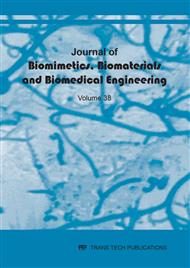[1]
Coresh J, Byrd-Holt D, Astor BC, Briggs JP, Eggers P W, Lacher DA, et al. Chronic kidney disease awareness, prevalence and trends among U.S. adults, 1999 to 2000. J Am Soc Nephrol. 16(1):180-8 (2005).
DOI: 10.1681/asn.2004070539
Google Scholar
[2]
Mezzano S, Aros C. Chronic kidney disease: classification, mechanisms of progression and strategies for renoprotection. Rev Med Chil. 133(3):338-48 (2005) Spanish.
Google Scholar
[3]
United States Renal Data System. 2013 USRDS annual data report: atlas of chronic kidney disease and end-stage renal disease in the United States. Am J Kidney Dis. 63(1 Suppl):e1-e478 (2014).
DOI: 10.1053/s0272-6386(05)01820-2
Google Scholar
[4]
Information on https://www.theisn.org/initiatives/ckd - International Society of Nephrology [Internet]. Brussels; c2017 [cited 2017 Jul 11].
Google Scholar
[5]
KDOQI; National Kidney Foundation. KDOQI clinical practice guidelines and clinical practice recommendations for anemia in chronic kidney disease. Am J Kidney Dis. 47(5 Suppl 3):S11-145 (2006).
DOI: 10.1053/j.ajkd.2006.12.005
Google Scholar
[6]
Maeshima A, Nakasatomi M, Nojima Y. Regenerative medicine for the kidney: renotropic factors, renal stem/progenitor cells and stem cell therapy. Biomed Res Int. 595493 (2014).
DOI: 10.1155/2014/595493
Google Scholar
[7]
Pino CJ, Humes HD. Stem cell technology for the treatment of acute and chonic renal failure. Transl Res. 156(3):161-8 (2010).
Google Scholar
[8]
Fissell WH, Fleischman AJ, Humes HD, Roy S. Development of continuous ilantable renal replacement: past and future. Transl Res. 150(6):327-36 (2007).
DOI: 10.1016/j.trsl.2007.06.001
Google Scholar
[9]
Montserrat N, Garreta E, Izpisua Belmonte JC. Regenerative strategies for kidney engineering. FEBS. 283(18):3303-24 (2016).
DOI: 10.1111/febs.13704
Google Scholar
[10]
Tapias LF, Ott HC. Decellularized scaffolds as a platform for bioengineered organs. Curr Opin Organ Transplant. 19(2):145-52 (2014).
DOI: 10.1097/mot.0000000000000051
Google Scholar
[11]
Crapo PM, Gilbert TW, Badylak SF. An overview of tissue and whole organ decellularization processes. Biomaterials. 32(12):3233-43 (2011).
DOI: 10.1016/j.biomaterials.2011.01.057
Google Scholar
[12]
He M, Callanan A. Comparison of methods for whole-organ decellularization in tissue engineering of bioartificial organs. Tissue Eng Part B Rev. 19(3):194-208 (2013).
DOI: 10.1089/ten.teb.2012.0340
Google Scholar
[13]
Keane TJ, Swinehart I, Badylak SF. Methods of tissue decellularization used for preparation of biologic scaffolds and in-vivo relevance. Methods. 84:25-34 (2015).
DOI: 10.1016/j.ymeth.2015.03.005
Google Scholar
[14]
Nakayama KH, Lee CC, Batchelder CA, Tarantal AF. Tissue specificity of decellularized rhesus monkey kidney and lung scaffolds. PLoS One. 8(5):e64134 (2013).
DOI: 10.1371/journal.pone.0064134
Google Scholar
[15]
Patient mortality and survival. United States Renal Data System. Am J Kidney Dis. 32(2 Suppl 1):S69-80 (1998).
Google Scholar
[16]
Humes HD, Szczypka MS. Advances in cell therapy for renal failure. Transpl. Immunol. 12(3-4):219-27 (2004).
Google Scholar
[17]
Ott HC, Matthiesen TS, Goh SK, Black LD, Kren SM, Netoff TI, et al. Perfusion-decellularized matrix: using nature's plataform to engineer a bioartificial heart. Nat Med. 14(2):213-21 (2008).
DOI: 10.1038/nm1684
Google Scholar
[18]
Baptista PM, Siddiqui MM, Lozier G, Rodriguez SR, Atala A, Soker S. The use of whole organ decellularization for the generation of a vascularized liver organoid. Hepatology. 53(2):604-17 (2011).
DOI: 10.1002/hep.24067
Google Scholar
[19]
Ott HC, Clippinger B, Conrad C, Schuetz C, Pomerantseva I, Ikonomou L, et al. Regeneration and orthotopic transplantation of a bioartificial lung. Nat Med. 16(8):927-31 (2010).
DOI: 10.1038/nm.2193
Google Scholar
[20]
Ross EA, Williams MJ, Hamazaki T, Terada N, Clapp WL, Adin C, et al. Embryonic stem cells proliferate and differentiate when seeded into kidney scalffolds. J Am Soc Nephrol. 20(11):2338-47 (2009).
DOI: 10.1681/asn.2008111196
Google Scholar
[21]
Bonandrini B, Figliuzzi M, Papadimou E, Morigi M, Perico N, Casiraghi F, et al. Recellularization of well-preserved acellular kidney scaffold using embryonic stem cells. Tissue Eng Part A. 20(9-10):1486-98 (2017).
DOI: 10.1089/ten.tea.2013.0269
Google Scholar
[22]
Song JJ, Guyette JP, Gilpin SE, Gonzalez G, Vacanti JP, Otto HC. Regeneration and experimental orthotopic transplantation of a bioengineered kidey. Nat Med. 19(5):646-51 (2013).
DOI: 10.1038/nm.3154
Google Scholar
[23]
Wang Y, Bao J, Wu Q, Zhou Y, Li Y, Wu X, et al. Method for perfusion decellularization of porcine whole liver and kidney for use as a scaffold for clinical-scale bioengineering engrafts. Xenotransplantation. 22(1):48-61 (2015).
DOI: 10.1111/xen.12141
Google Scholar
[24]
Kim SS, Sundback CA, Kaihara S, Benvenuto MS, Kim BS, Mooney DJ, et al. Dynamic seeding and in vitro culture of hepatocytes in a flow perfusion system. Tissue Eng. 6(1):39-44 (2000).
DOI: 10.1089/107632700320874
Google Scholar
[25]
Westover AJ, Buffington DA, Humes HD. Enhanced propagation of adult renal epithelial progenitor cells to improve cell sourcing for tissue engineered therapeutic devices for renal diseases. J Tissue Eng Regen Med. 6(8):589-97 (2012).
DOI: 10.1002/term.471
Google Scholar
[26]
Smith PL, Buffington DA, Humes HD. Kidney epithelial cells. Methods Enzymol. 419:194-207 (2006).
Google Scholar


